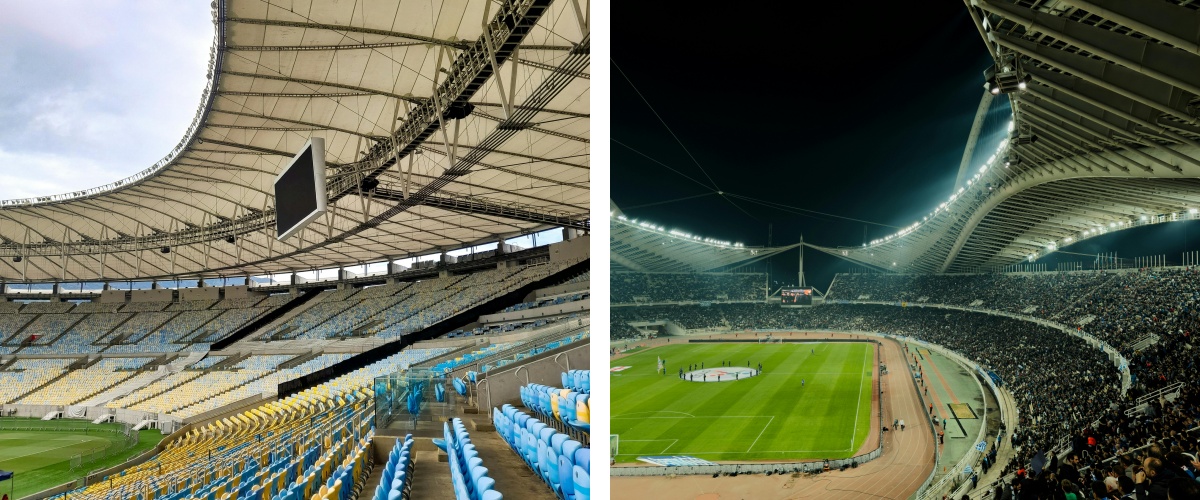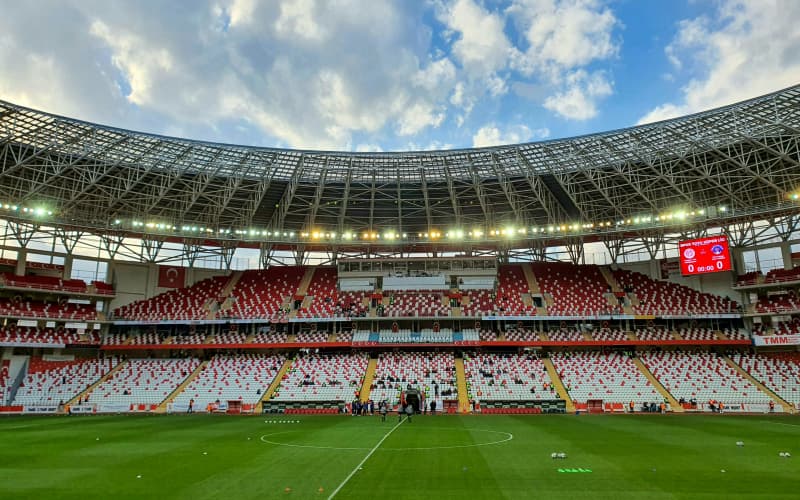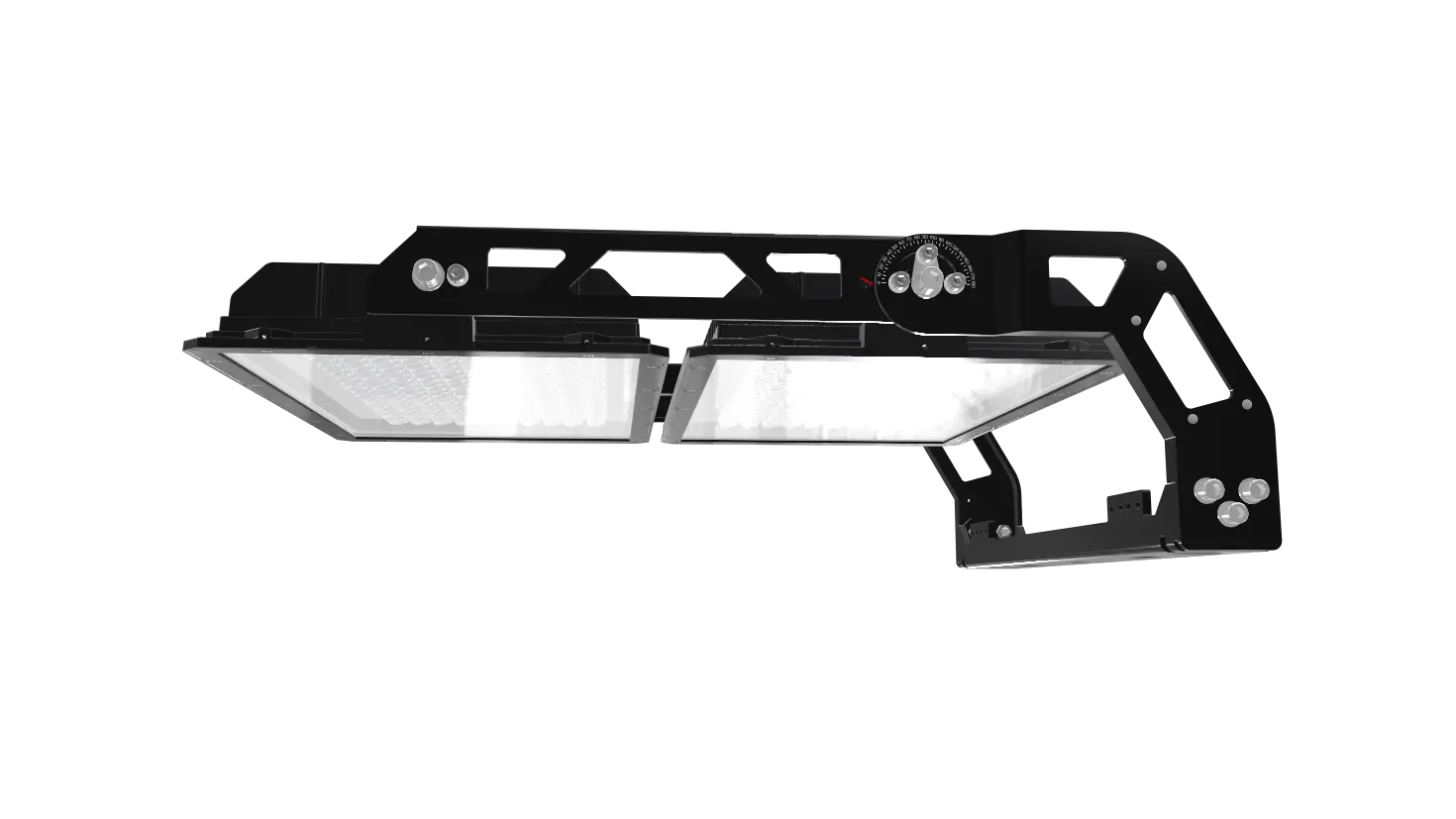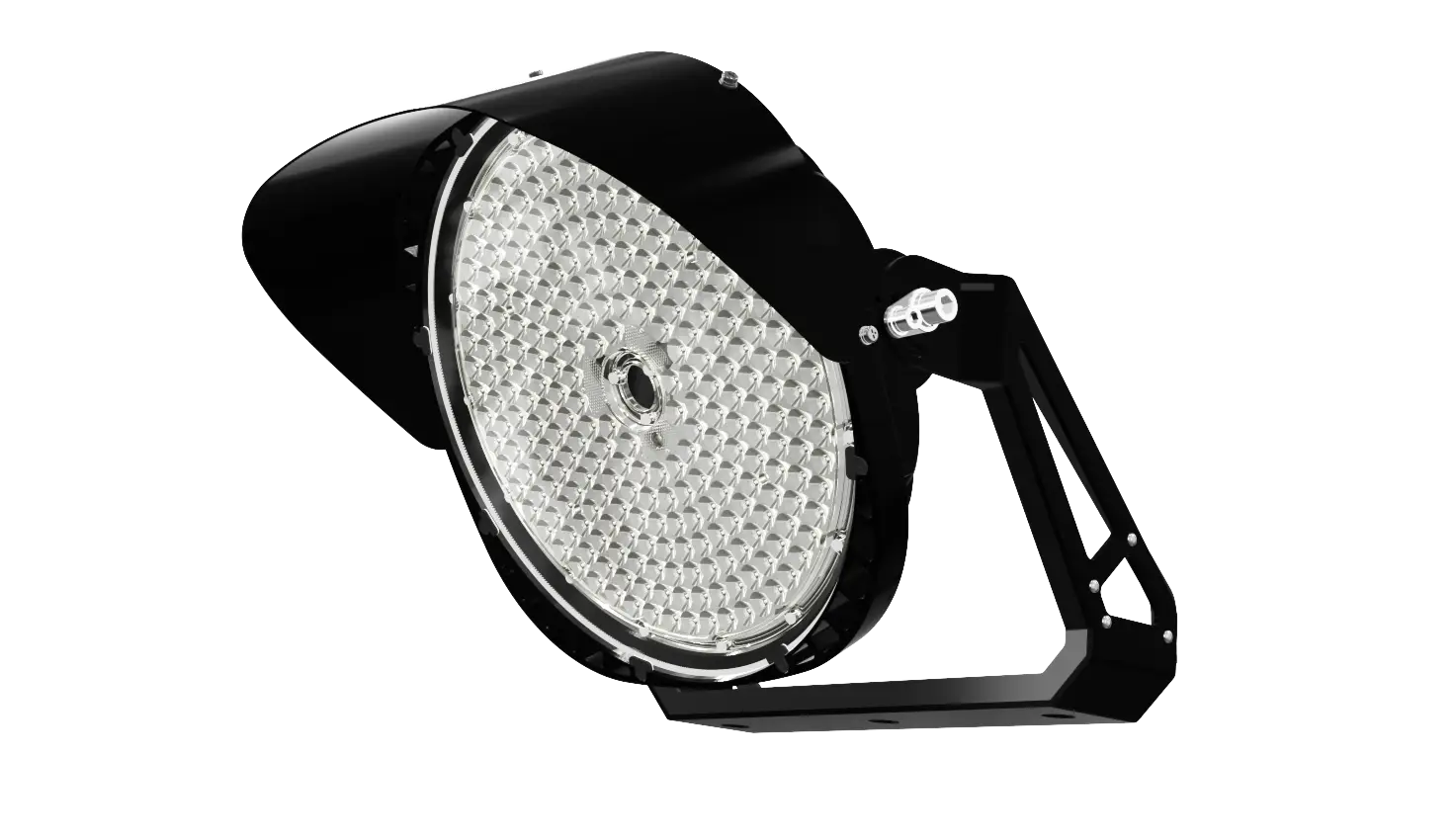LED体育场灯指南:成本、优势和标准
照明是现代体育设施中最关键的因素之一。从专业赛场到社区运动场,照明质量直接影响着运动员的表现和观众的体验。
金属卤化物和高压钠灯等传统 HID 灯具长期以来一直是标准,但它们在能源效率、色彩准确度和维护成本方面的局限性正变得越来越明显。
这正是 LED 体育场灯大显身手的地方。它们能够提供更明亮、更均匀的照明,减少眩光,同时还能降低长期运营成本。无论是橄榄球、棒球、足球还是多功能场馆,LED 现已成为全球体育场馆运营商的首选。

目录:
7. 为什么选择 CeramicLite 作为 LED 体育场灯?
1.什么是LED体育场灯?
LED体育场灯(发光二极管体育场灯的简称)是专为体育场馆设计的专用照明系统。与依靠加热灯丝或气体放电发光的传统灯具不同,LED灯使用半导体芯片将电能直接转化为可见光。这种根本性的技术差异赋予了LED独特的优势,使其能够满足体育场馆对亮度、一致性和可靠性的要求。
高品质体育场 LED 灯的核心包括三个关键组件:
(1) 高亮度 LED 芯片:这些芯片通常由氮化镓 (GaN) 材料制成,可发出强光,具有高发光效率(通常为每瓦 130-180 流明,lm/W),确保即使是最大的体育场也能获得足够的照明。
(2) 先进的散热系统:由于 LED 产生的热量极少(与传统灯具相比),但过多的热量会缩短使用寿命,因此体育场设计的顶级 LED 灯包括铝合金散热器或陶瓷散热结构,以保持芯片冷却。
(3) 精密光学镜片:可定制的镜片(光束角范围从 15° 到 120°)将光线准确地引导到需要的地方 - 无论是覆盖 100 码的足球场还是聚焦在篮球场上 - 避免浪费光线和眩光。

2. 体育场使用LED灯的主要优势
Upgrading to LED stadium lights is not only about brighter fields—it's about transforming the entire sports experience while reducing operational costs. Here are the main advantages that make them the preferred choice for modern venues.
2.1 Energy Efficiency and Cost Reduction
Compared with traditional metal halide or HPS lamps, stadium lights LED consume up to 60–70% less electricity. This translates into massive yearly savings, especially for large stadiums running lights for hundreds of hours per season. The higher luminous efficacy (lumens per watt) ensures that less power is needed to achieve the same—or better—illumination levels.
2.2 Long Lifespan and Low Maintenance
While conventional lamps may last 3,000–10,000 hours, an LED stadium light can operate for 50,000 hours or more. Fewer replacements mean less downtime, reduced labor costs, and uninterrupted sporting schedules. For stadium operators, this long-term reliability directly improves ROI.
2.3 Better Broadcast Quality and Anti-Glare Design
Modern sports broadcasting demands flicker-free, high-quality lighting. LED stadium lights deliver stable, instant illumination with no warm-up delay, making slow-motion replays crisp and clear. Additionally, advanced optics minimize glare, enhancing player visibility and improving spectator comfort in both live and televised events.
2.4 Enhanced Flexibility and Control
Unlike traditional systems, stadium lights LED can integrate with smart control platforms. Operators can dim, program light shows, or switch lighting modes depending on the event—be it a football match, a concert, or a community gathering.
Having seen the advantages, the next step is to understand how LED lighting standards for stadiums define the right brightness, uniformity, and visual comfort for professional play.
3. LED Lighting Standards for Stadiums
When investing in LED stadium lights, it is crucial to follow international benchmarks to guarantee player safety, spectator comfort, and broadcast quality. Industry authorities like FIFA, FIBA, and CIE have established widely accepted LED lighting standards for stadiums that guide design and installation.

3.1 Recommended Illuminance Levels
Different sports require different brightness levels:
FIFA football stadiums: 500 lux for training fields, 2000 lux for HDTV broadcasting.
FIBA basketball arenas: minimum 750 lux for community play, 1500–2000 lux for professional matches.
CIE guidelines: recommend an illuminance level at least 3 times higher than the ambient light (E = 3 × environment lux).
These benchmarks ensure players see the ball clearly, referees make accurate calls, and cameras capture sharp images.
3.2 Uniformity of Light Distribution
It is not enough to achieve high brightness; the light must also be evenly spread. The uniformity ratio (U1 = Emin / Eavg) should reach at least 0.7 for professional arenas. Poor uniformity creates dark patches and glare spots, reducing performance and increasing eye strain.
3.3 Color Rendering Index (CRI)
High-quality stadium LED lights should have a CRI above 80, ideally 90+, to accurately display team colors and advertising banners. This is vital for both live spectators and TV audiences, ensuring the visual experience matches real-life colors.
3.4 Glare and UGR Limits
Glare control is a critical safety factor. CIE recommends a Unified Glare Rating (UGR) below 22 for stadium environments. Advanced lens designs in modern LED stadium lights minimize direct glare, giving athletes clearer vision and making matches more comfortable for the crowd.
With standards clarified, the next question most stadium owners ask is—beyond compliance—how do LED stadium lights save money over time? That's what we will explore in the next chapter.
4. How LED Stadium Light Helps Save Money?
Investing in LED lights stadium systems may seem costly at first, but the long-term savings far outweigh the initial expense. The financial benefits come from both direct and indirect cost reductions.
4.1 Lower Energy Consumption
Traditional metal halide and HPS lamps waste energy as heat. In contrast, LED stadium lights convert most power into visible light, cutting electricity bills by up to 70%. For large venues, this translates to tens of thousands of dollars in annual savings.
4.2 Reduced Maintenance Costs
With a lifespan exceeding 50,000 hours, LED stadium lights require far fewer replacements than halide lamps. This reduces the expense of new bulbs, labor for installation, and downtime caused by lighting failures.
4.3 Avoiding Event Disruptions
Unexpected lamp failures during games can cause delays or rescheduling, leading to lost revenue. LEDs provide instant, reliable illumination with no warm-up time, ensuring uninterrupted schedules and smoother operations.
4.4 Maximizing ROI Through Incentives
In many regions, switching to LED lights stadium solutions qualifies for government rebates or energy-efficiency subsidies. These programs accelerate payback time and improve return on investment.
Transition: Beyond cost savings, stadium owners also need to consider practical factors such as installation speed and project timelines. That's the focus of the next chapter.
5. Applications of LED Stadium Lights
The versatility of LED stadium lights makes them suitable for nearly every type of sports facility and event space. From professional arenas to community venues, their performance ensures both athletes and audiences get the best experience.

5.1 Football and Soccer Fields
LED football stadium lights are designed to deliver high lux levels, wide beam angles, and uniform coverage. They meet FIFA standards for international matches, ensuring clear visibility for players and broadcast cameras.
5.2 Basketball Arenas and Indoor Gyms
Basketball requires quick movement recognition and accurate color rendering. LED lighting ensures high CRI for better visibility of the ball, court markings, and team jerseys, improving both gameplay and spectator enjoyment.
5.3 Athletics Tracks and Multi-Sport Fields
Athletics venues need consistent lighting across large areas. LED floodlights offer precise beam control, minimizing shadows on tracks and field events like javelin, high jump, and discus.
5.4 Baseball Fields
Baseball demands vertical and horizontal illumination since the ball is small and fast-moving. LED stadium lights provide bright, uniform coverage for both the infield and outfield, reducing blind spots.
5.5 Stands, Exteriors, and Roof Installations
Beyond the playing field, LED stadium lights enhance audience comfort in stands, improve safety in parking areas, and create visual impact with roof-mounted displays or synchronized light shows during ceremonies.
Knowing where to apply lighting is only part of the decision. The next step is choosing the right specifications and models to ensure lasting performance.
6. How to Choose the Right Stadium LED Lights?
Selecting the right stadium LED lights requires more than just meeting brightness levels. Buyers need to evaluate technical parameters, durability, and suitability for their specific venue.
6.1 Core Technical Parameters
Luminous efficacy (lm/W): Determines energy efficiency. High-quality LED stadium lights deliver >130 lm/W, providing strong illumination with lower power use.
Illuminance levels: Match sport-specific standards (e.g., 2000 lux for professional football broadcasting).
Color Rendering Index (CRI): Look for CRI ≥ 80, ideally 90+, to ensure accurate colors on jerseys and advertisements.
Ingress Protection (IP rating): Outdoor installations require IP65+ to withstand rain, dust, and wind.
6.2 Types of Stadium Fixtures
Floodlights: Broad beams ideal for large football or baseball fields.
High-mast lights: Tall-pole systems for even coverage across big arenas.
Area lights: Designed for stands, concourses, and parking zones.
6.3 Certifications and After-Sales Support
When sourcing stadium LED lights, ensure compliance with UL, CE, or DLC certifications for safety and performance. A reliable supplier also provides warranties, spare parts, and quick technical support to keep venues running smoothly.
Once the right product is selected, the final step is to choose a trusted supplier with proven expertise and successful case studies.
7. Why Choose CeramicLite for LED Stadium Lights?
When it comes to high-performance LED stadium lights, choosing the right supplier is just as important as selecting the right fixture. Ceramiclite brings together advanced technology, durable engineering, and long-term reliability to deliver solutions that meet the demanding needs of modern sports venues.
7.1 Advanced Ceramic LED Technology
At the core of every Ceramiclite luminaire is its proprietary FTC (transparent ceramic phosphor) material. Unlike conventional packaging, FTC offers superior thermal stability, excellent lumen maintenance, and resistance to sulfur, ammonia, acids, and alkalis. This means brighter, more reliable lighting even under extreme conditions.
7.2 Products Designed for Performance
Ceramiclite's sports lighting range includes the SL03 and SL04 stadium lights:
Sports Light SL03: Lightweight, modular, and wind-resistant, with CRI/TLCI 90 and DALI 2.0 smart control. Ideal for football fields, baseball arenas, and community sports facilities.
Sports Light SL04: Engineered for professional arenas with opto-electrical separation, multi-protocol dimming (0–10V, DALI, DMX), advanced glare control, and seamless HID replacement options.
Both models are IP66/IK08 rated, equipped with 20KV surge protection, and tested to last over 100,000 hours (L80B10).
7.3 Durability and Safety Assured
Ceramiclite products are designed for harsh environments. Features such as C4 anti-corrosion, bird-proof cabling, and dual-layer lens protection ensure consistent performance in outdoor stadiums, coastal regions, and high-humidity areas. International certifications like UL and CE guarantee compliance with global safety standards.
7.4 Long-Term Value
Beyond technology, Ceramiclite offers extended warranties of up to 10 years, reducing ownership costs for stadium operators. With intelligent lighting controls, venues can optimize energy use and qualify for sustainability incentives, maximizing return on investment.
With a trusted partner like Ceramiclite, stadium operators can confidently move forward, knowing they have both cutting-edge lighting and dependable long-term support. Next, let's wrap up with the key reasons why LED stadium lights are the ultimate choice for modern sports facilities.
8. Conclusion
LED Stadium Lights are more than just a replacement for traditional lamps—they deliver significant energy savings, long-term cost reduction, superior visual experience, and a practical installation cycle that fits modern stadium needs. By meeting international standards and ensuring player and spectator comfort, they have become the top choice for sports facilities worldwide.
If you are planning a new project or upgrading existing systems, now is the time to switch. Contact us today to get a tailored solution and a free quote for LED Stadium Lights.
9. FAQs
Q1: How long do LED stadium lights last?
大多数 LED 体育场灯的使用寿命为 50,000 至 100,000 小时,与传统灯具相比,可最大限度地降低更换成本。
问题 2:LED 足球场灯适合户外天气吗?
是的。高品质灯具配备 IP65–IP67 防护等级,可有效抵御雨水、灰尘和温度变化。
问题 3:LED 体育场灯可以减少球员和球迷的眩光吗?
现代体育场灯光遵循UGR防眩光标准并采用精确的光学元件,确保舒适性和安全性。
Q4:与传统灯相比,它们的节能效果如何?
LED 体育场照明的能耗降低了 50-70%,每瓦的流明输出更高。
Q5:安装LED体育场照明需要多长时间?
通常需要几天到几周的时间,具体取决于体育场的大小、杆的高度和布线的复杂程度。
Q6:LED体育场灯符合国际标准吗?
是的,顶级解决方案符合 FIFA、FIBA 和 CIE 照明标准,涵盖亮度、均匀性和显色性。
相关产品
_thumb.jpg)

